Simulation of the Jet Fire Using Atmospheric Dispersion Modeling (ALOHA): A Case Study of Natural Gas Pipeline in Istanbul, Türkiye
Abstract
1. Introduction
2. Data and Methodology
2.1. Occurence of the Accident
2.2. ALOHA Program
2.3. Input Chemical and Atmospheric Conditions into the ALOHA
- Red threat zone: 10.0 kW/m2 (potentially fatal within 60 s)
- Orange threat zone: 5.0 kW/m2 (second degree burns within 60 s)
- Yellow threat zone: 2.0 kW/m2 (pain within 60 s)
3. Results and Discussion
3.1. Threat Distances Based on Source Release Factors
- Date: 28 April 2020
- Time: 11:07 a.m. LT (Atmospheric conditions measured at 11:00 a.m. for 11:07 a.m. are used)
- Wind speed: 3.1 m/s
- Wind direction: 115°
- Cloud cover: Clear
- Air temperature: 17.6 °C
- Atmospheric stability class: C
- Inversion height: 1461 m
- Relative humidity: 57%
- Pipe temperature: 12.3 °C
3.2. The Impact of Large- and Local-Scale Atmospheric Circulations on Threat Distances for the Selected Jet Fire Episode
- Date: 28 April 2020
- Cloud cover: Clear
- Inversion height: 1461 m
- Pipe diameter: 125 mm (12.5 cm)
- Pipe length: 25 m
3.3. Threat Distances Based on Monthly Average Atmospheric Conditions
- Inversion height: 1000 m
- Pipe diameter: 125 mm (12.5 cm)
- Pipe length: 25 m
3.4. Sensitivity of Threat Distances to Changes in Meteorological Parameters
- Date: 28 April 2020
- Time: 11:07 a.m. LT
- Wind speed: 2.4 m/s
- Wind direction: North-northeast (NNE)
- Cloud cover: 5 (Cloud cover can be defined as integers between 0 (clear) and 10 (complete cover) to the ALOHA program.)
- Air temperature: 11.8 °C
- Inversion height: 1000 m
- Relative humidity: 73%
- Pipe diameter: 125 mm (12.5 cm)
- Pipe length: 25 m
- Pipe temperature: 12.2 °C
3.5. Threat Distances for Worst Case Scenario
- Date: 28 April 2020
- Time: 11:07 LT
- Wind speed: 30.9 m/s (The highest wind speed measured between 1960 and 2020)
- Wind direction: North–northeast (NNE)
- Cloud cover: 0 (Clear)
- Air temperature: −12.6 °C (The lowest temperature measured between 1960 and 2020)
- Atmospheric stability class: D
- Inversion height: 1000 m
- Relative humidity: 5%
- Pipe diameter: 125 mm (12.5 cm)
- Pipe length: 25 m
- Pipe temperature: 5.8 °C (The lowest soil temperature was measured at 100 cm depth between 1960 and 2020)
4. Summary and Conclusions
- Source release factors have a significant effect on the threat distances, the threat distances decrease non-linearly as the pipe length increases and the threat distances increase depending on the burning rate as the pipe diameter increases.
- Threat distances do not change significantly depending on the stable atmospheric conditions for wind speed and temperature; however, there is only a 1 m difference in the threat distances for certain time intervals. From the monthly averages, threat distances are slightly longer during winter months and shorter in the summer months.
- From the meteorological parameters; wind speed, air temperature and relative humidity are effective to identify threat distances in the specified intervals. It has been found that as the wind speed increases, the threat distances increase due to the bending of the jet flame more in the wind direction, and the threat distances decrease as the air temperature and relative humidity increase. From the results, cloud cover does not show significant impact on threat distances.
- From the worst scenario, red, orange and yellow threat distances were calculated as 21 m, 28 m and 42 m, respectively. These calculated values can be used a reference for the determination of safe distances, especially during emergency intervention and evacuation works related to jet fires occurring in natural gas distribution pipelines and also during infrastructure works.
Author Contributions
Funding
Institutional Review Board Statement
Informed Consent Statement
Data Availability Statement
Conflicts of Interest
References
- Şahingöz, D. Genel Doğal Gaz, 3rd ed.; Bulundu, H., Say, S.S., Eds.; UGETAM Yayınları: Ankara, Turkey, 2016; Available online: https://ugetam.istanbul/wp-content/uploads/2020/12/Genel-Dogalgaz.pdf (accessed on 10 May 2021).
- Vianello, C.; Maschio, G. Quantitative Risk Assesment of The Italian Gas Distribution Network. J. Loss Prev. Process Ind. 2014, 32, 5–17. [Google Scholar] [CrossRef]
- Azari, P.; Karimi, M. Quantitative Risk Mapping of Urban Gas Pipeline Networks Using GIS. Int. Arch. Photogramm. Remote Sens. Spat. Inf. Sci. 2017, XLII-4/W4, 319–324. [Google Scholar] [CrossRef]
- Heidari, P.A.; Ebrahemzadih, M.; Farahani, H.; Khoubi, J. Quantitative Risk Assessment in Iran’s Natural Gas Distribution Network. Open J. Saf. Sci. Technol. 2014, 4, 59–72. [Google Scholar] [CrossRef][Green Version]
- Uçar, S. Türkiye’de Kazı Kaynaklı Doğal Gaz Boru Hattı Hasarları, Etkin Müdahale Usulleri, Kazı Hasarlarının Önemli Ölçüde Azaltılması Için Öneriler ve İnovatif Sistem Örneği; Gazbir-Gazmer. Available online: https://www.gazmer.com.tr/upload/tr/dosya/dokumanyonetimi/31/KAZICI-DELICI-I%C5%9E-MAKINASI-KAYNAKLI-BORU-HATTI-HASARLARININ-AZALTILMASI-ICIN-INOVATIF-SISTEM-ORNEGI_08102021091623-2.pdf (accessed on 7 December 2020).
- Han, Z.Y.; Weng, W.G. Comparison Study on Qualitative and Quantitative Risk Assessment Methods for Urban Natural Gas Pipeline Network. J. Hazard. Mater. 2011, 189, 509–518. [Google Scholar] [CrossRef] [PubMed]
- Joe, Y.-D.; Ahn, B.J. Analysis of Hazard Area Associated with Pressure Natural-Gas Pipeline. J. Loss Prev. Process Ind. 2022, 15, 179–188. [Google Scholar] [CrossRef]
- Bubbico, R.; Di Cave, S.; Mazzarotta, B. Preliminary Risk Analysis for LNG Tankers Approaching a Maritime Terminal. J. Loss Prev. Process Ind. 2009, 22, 634–638. [Google Scholar] [CrossRef]
- Bernatik, A.; Senovsky, P.; Pitt, M. LNG as a Potential Alternative Fuel–Safety and Security of Storage Facilities. J. Loss Prev. Process Ind. 2011, 24, 19–24. [Google Scholar] [CrossRef]
- Kalatpoor, O.; Goshtaps, K.; Khavajı, S. Health, Safety and Environmental Risk of a Gas Pipeline in an Oil Exploring Area of Gachsaran. Ind. Health 2011, 49, 209–214. [Google Scholar] [CrossRef]
- Kent Muhlbauer, W. Pipeline Risk Management Manual Ideas, Techniques and Resources, 3rd ed.; Gulf Professional Publishing: Burlington, MA, USA, 2004. [Google Scholar]
- Shao, H.; Duan, G. Risk Quantitative Calculation and ALOHA Simulation on The Leakage Accident of Natural Gas Power Plant. Procedia Eng. 2012, 45, 352–359. [Google Scholar] [CrossRef]
- Zhu, H.; Mao, Z.; Wang, Q.; Sun, J. The Influences of Key Factors on The Consequences Following the Natural Gas Leakage from Pipeline. Procedia Eng. 2013, 62, 592–601. [Google Scholar] [CrossRef]
- Zhou, Y.; Hu, G.; Li, J.; Diao, C. Risk Assesment Along the Gas Pipelines and Its Application in Urban Planning. Land Use Policy 2014, 38, 233–238. [Google Scholar] [CrossRef]
- Bajcar, T.; Cimerman, F.; Širok, B. Towards More Detailed Determination of Third Party Impact on Risk on Natural Gas Pipelines: Influence of Population Density. Process Saf. Environ. Prot. 2015, 94, 509–516. [Google Scholar] [CrossRef]
- Hanafiah, N.M.; Zardasti, L.; Yahaya, N.; Noor, N.M.; Hassan, N.; Valipour, A. Comparision Study on Human Health and Safety Loss for Rural and Urban Areas in Monetary Value Subjected to Gas Pipeline Failure. J. Environ. Sci. Technol. 2015, 8, 300–309. [Google Scholar] [CrossRef][Green Version]
- Ebrahemzadih, M.; Haedari, P.A. Investigating the Likelihood of Catastrophic Events in Natural Gaz Pipelines Using an Integration of Fault Tree Analysis and What–If Methods. Sigurnost 2016, 58, 18–30. [Google Scholar] [CrossRef]
- Çetinyokuş, S. Sonuç Analizi ile Belirlenen Etki Mesafeleri Üzerine Atmosferik Seçimlerin Etkisi (ALOHA Yazılımı). Afyon Kocatepe Üniv. Mühendis. Bilim. Derg. 2017, 17, 209–217. [Google Scholar] [CrossRef]
- Tawfik, F.S.; Nassar, N.; Abdel Aziz, M.A.H. Environmental Impact of Conventional Power Plant in Normal and Accidental Conditions. Arab J. Nucl. Sci. Appl. 2018, 51, 68–81. [Google Scholar] [CrossRef]
- Khalid, N.A.; Tohir, M.Z.M.; Said, M.S.M. Consequence Simulation of Jet Fire Due to Leakage of Pipelines in a Natural Gas Power Plant in Malaysia. Perintis Ejournal 2019, 9, 15–29. [Google Scholar]
- Kotkava, B.; Hromada, M. Comparision of the Resulting Models of Dispersion of Hazardous Substances Created in the Software Aloha and TerEx. In Proceedings of the 20th International Multidisciplinary Scientific GeoConference SGEM 2020, Albena, Bulgaria, 16–25 August 2020. [Google Scholar] [CrossRef]
- Özay, M.E.; Köten, H.; Can, E. İstanbul Boğazı Geçişi Güvenlik Açığı: Olası Tanker Patlama Simülasyonu. Int. J. Pure Appl. Sci. 2021, 7, 509–516. [Google Scholar] [CrossRef]
- Vairo, T.; Pontiggia, M.; Fabiano, B. Critical Aspects of Natural Gas Pipelines Risk Assessments. A Case-study Application on Buried Layout. Process Saf. Environ. Prot. 2021, 149, 258–268. [Google Scholar] [CrossRef]
- Habertürk. Beylikdüzü’nde Doğalgaz Borusunda Patlama: 2 Yaralı. Available online: https://www.haberturk.com/son-dakika-haberler-beylikduzu-nde-dogalgaz-borusunda-patlama-2-yarali-2661329 (accessed on 14 December 2021).
- Republic of Türkiye Governership of Istanbul, Doğal Gaz Boru Hattında Patlama Olayı Basın Açıklaması. Available online: http://www.istanbul.gov.tr/dogalgaz-boru-hattinda-patlama-olayi-ile-ilgili-basin-aciklamasi (accessed on 14 December 2021).
- NOAA. ALOHA (Areal Location of Hazardous Atmospheres) 5.4.4. Technical Documentation. 2013. Available online: https://response.restoration.noaa.gov/sites/default/files/ALOHA_Tech_Doc.pdf (accessed on 9 May 2021).
- NOAA. ALOHA. 2020. Available online: https://response.restoration.noaa.gov/sites/default/files/aloha.pdf (accessed on 17 December 2021).
- Shah Md, T.R.; Tausif, S.; Sultana, R.S. Facility layout optimization of on ammonia plant based on risk and economic analysis. Proc. Eng. 2013, 90, 760–765. [Google Scholar]
- Bahareh, I.; Berrin, T. Explosion impacts during transport of hazardous Cargo: GIS-based characterization of overpressure impacts and delinaation of flammable zones for ammonia. J. Environ. Manag. 2015, 156, 1–9. [Google Scholar]
- Howari, F.M. Evaporation losses and dispersion of volatile organic compounds from tank farms. Environ. Monit. Assess. 2015, 187, 273. [Google Scholar] [CrossRef] [PubMed]
- Praveen, P.; Nagendra, S. Hazard evaluation using ALOHA tools in storage area of an oil refinery. Int. J. Renew. Energy Technol. 2015, 4, 203–209. [Google Scholar]
- Lucyna, B. Computer simulation of impacts of a chlorine tanker truck accident. Transp. Res. Part D Transp. Environ. 2016, 43, 107–122. [Google Scholar]
- Nilambar, B.; Indra, M.M.; Vimal, C.S. Fire and explosion hazard analysis during surface transport of liquid petroleum gas (LPG): A case study of LPG truck tanker accident in Kannur, Kerala, India. J. Loss Prev. Process Ind. 2016, 40, 449–460. [Google Scholar]
- Anjana, N.S.; Amarnath, A.; Harindranathan Nair, M.V. Toxic hazards of ammonia release and population vulnerability assessment using geographical information system. J. Environ. Manag. 2018, 210, 201–209. [Google Scholar] [CrossRef]
- Jones, R.; Lehr, W.; Simecek-Beatty, D.; Reynolds, M. ALOHA® (Areal Locations of Hazardous Atmospheres) 5.4. 4: Technical Documentation. 2013. Available online: https://repository.library.noaa.gov/view/noaa/2669 (accessed on 1 January 2024).
- Flocas, H.; Kelessis, A.; Helmis, C.; Petrakakis, M.; Zoumakis, M.; Pappas, K. Synoptic and local scale atmospheric circulation associated with air pollution episodes in an urban Mediterrenean area. Theor. Appl. Climatol. 2009, 95, 265–277. [Google Scholar] [CrossRef]
- Zhang, J.P.; Zhu, T.; Zhang, Q.H.; Li, C.C.; Shu, H.L.; Ying, Y.; Dai, Z.P.; Wang, X.; Liu, X.Y.; Liang, A.M. The impact of circulation patterns on regional transport pathways and air quality over Beijing and its surroundings. Atmos. Chem. Phys. 2012, 12, 5031–5053. [Google Scholar] [CrossRef]
- Baltaci, H.; Alemdar, C.S.O.; Akkoyunlu, B.O. Background atmospheric conditions of high PM10 concentrations in Istanbul, Turkey. Atmos. Pollut. Res. 2020, 11, 1524–1534. [Google Scholar] [CrossRef]
- Delouei, A.A.; Karimnejad, S.; Gharajeh, A.; Sajjadi, H.; Atashafrooz, M.; Xie, G.; Arabkoohsar, A. Bath heaters using alternative heat transfer medium: A thermo-economic analysis. J. Braz. Soc. Mech. Sci. Eng. 2023, 45, 73. [Google Scholar] [CrossRef]
- Delouei, A.A.; Naeimi, H.; Sajjadi, H.; Atashafrooz, M.; Imanparast, M.; Chamkha, A.J. An active approach to heat transfer enhancement in indirect heaters of city gase stations: An experimental modeling. Appl. Therm. Eng. 2024, 237, 121795. [Google Scholar] [CrossRef]

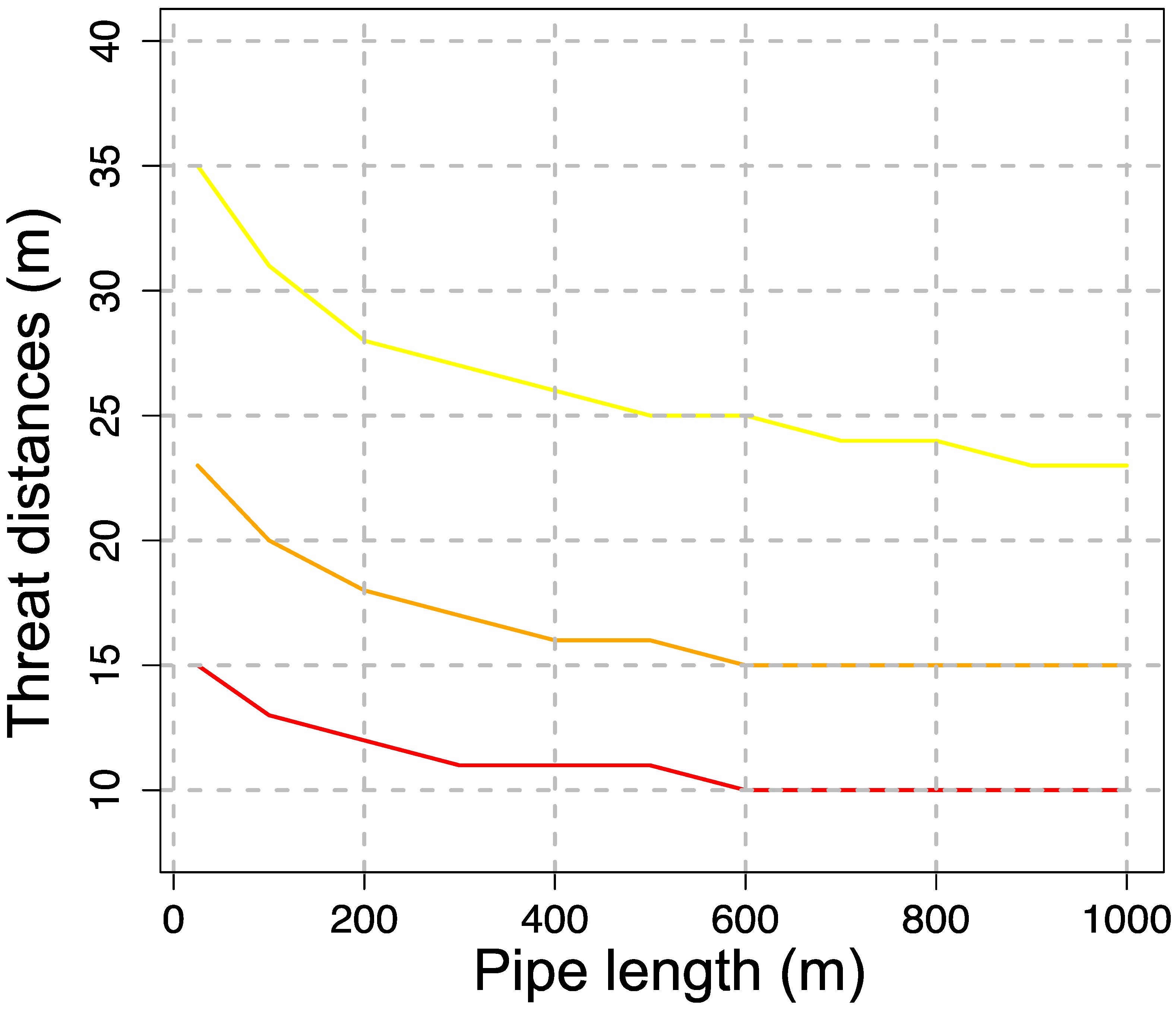
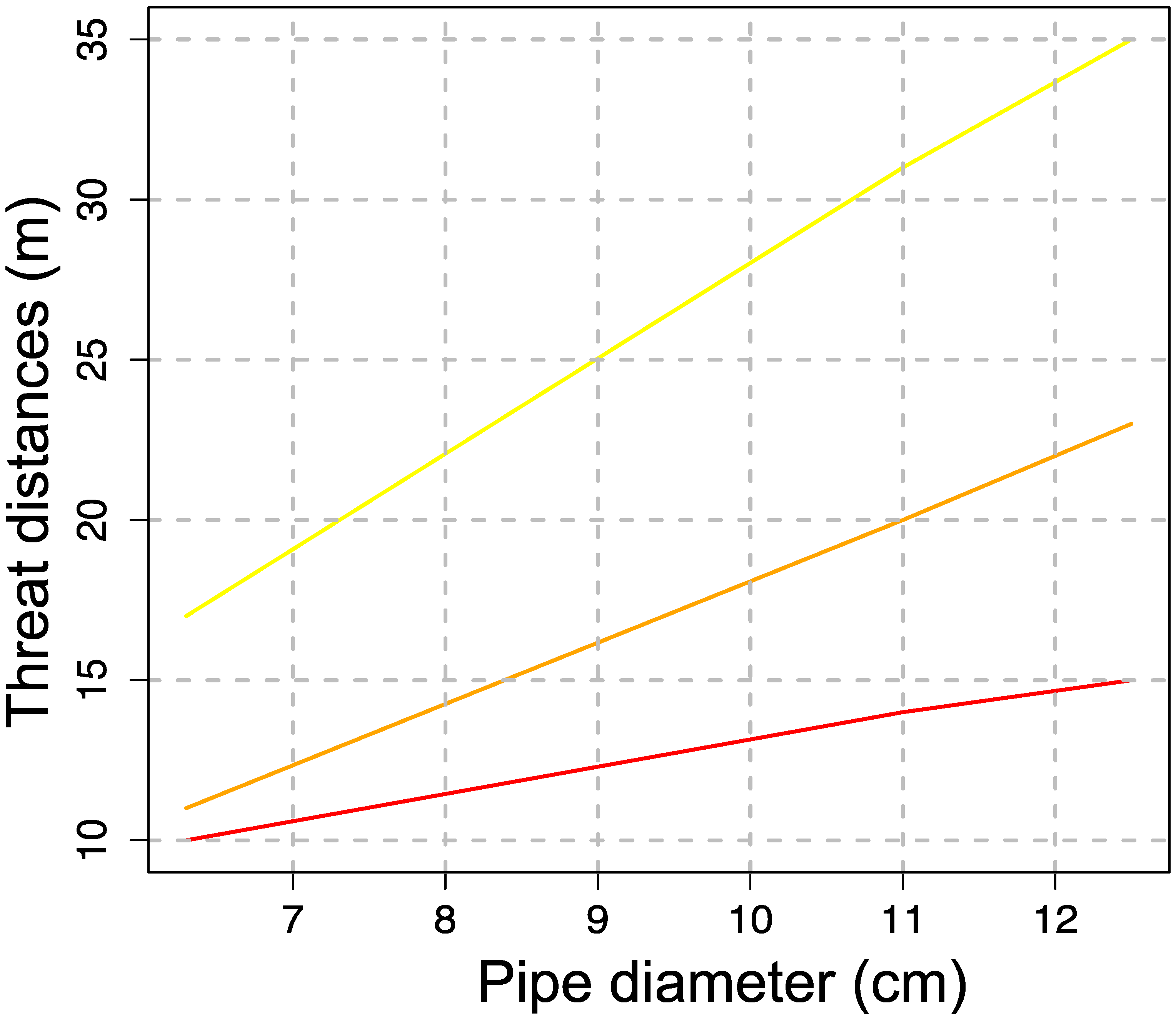
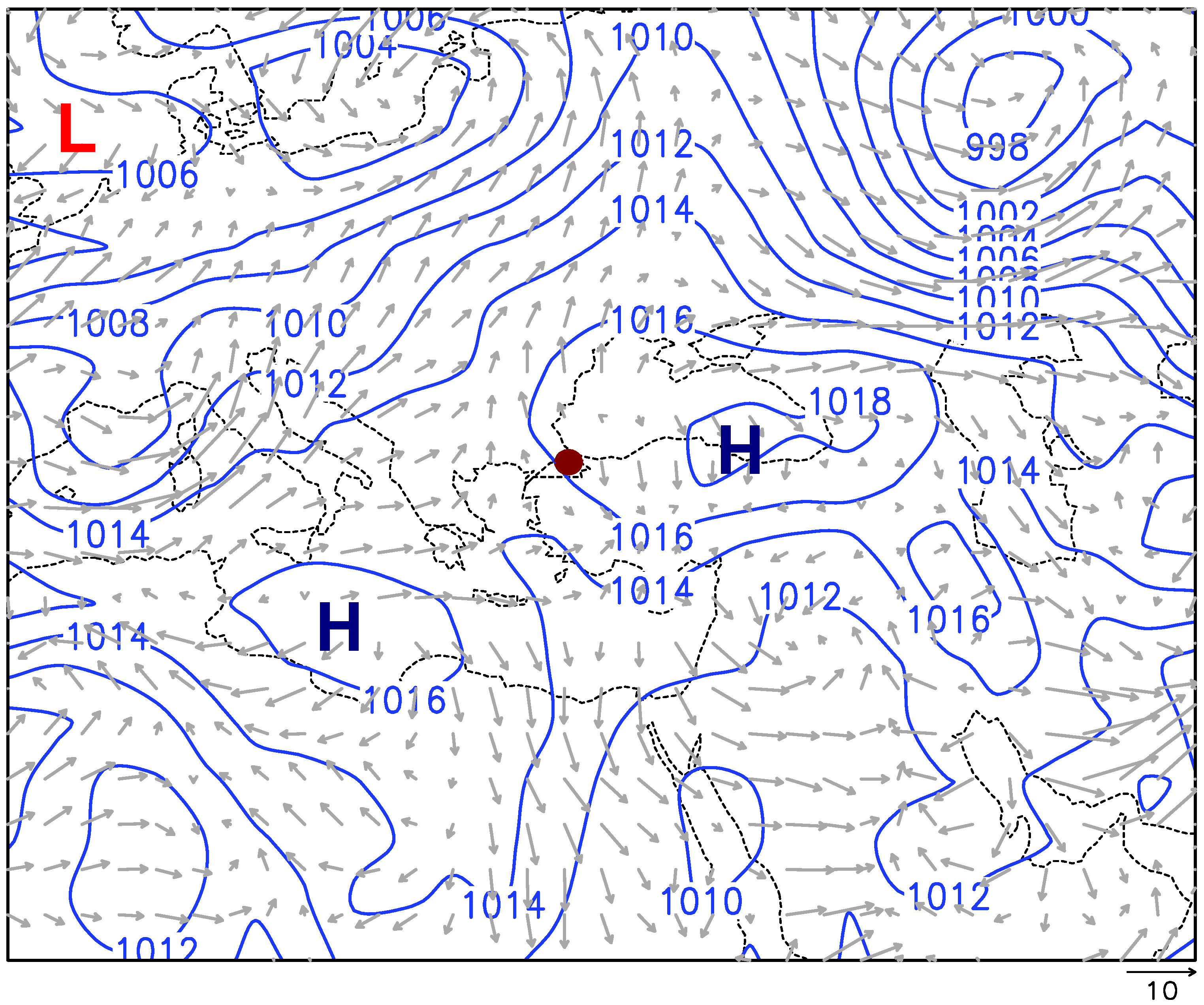

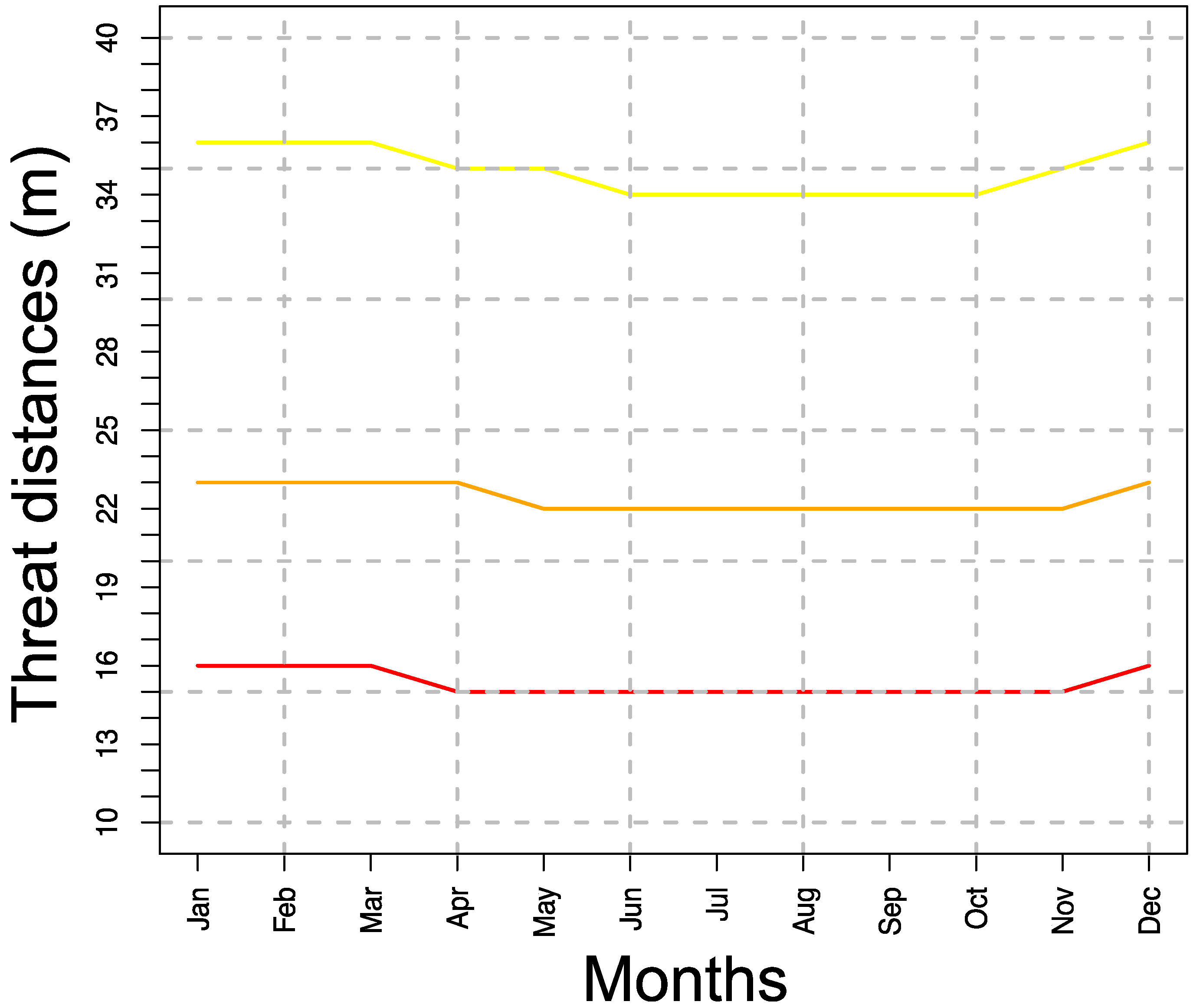
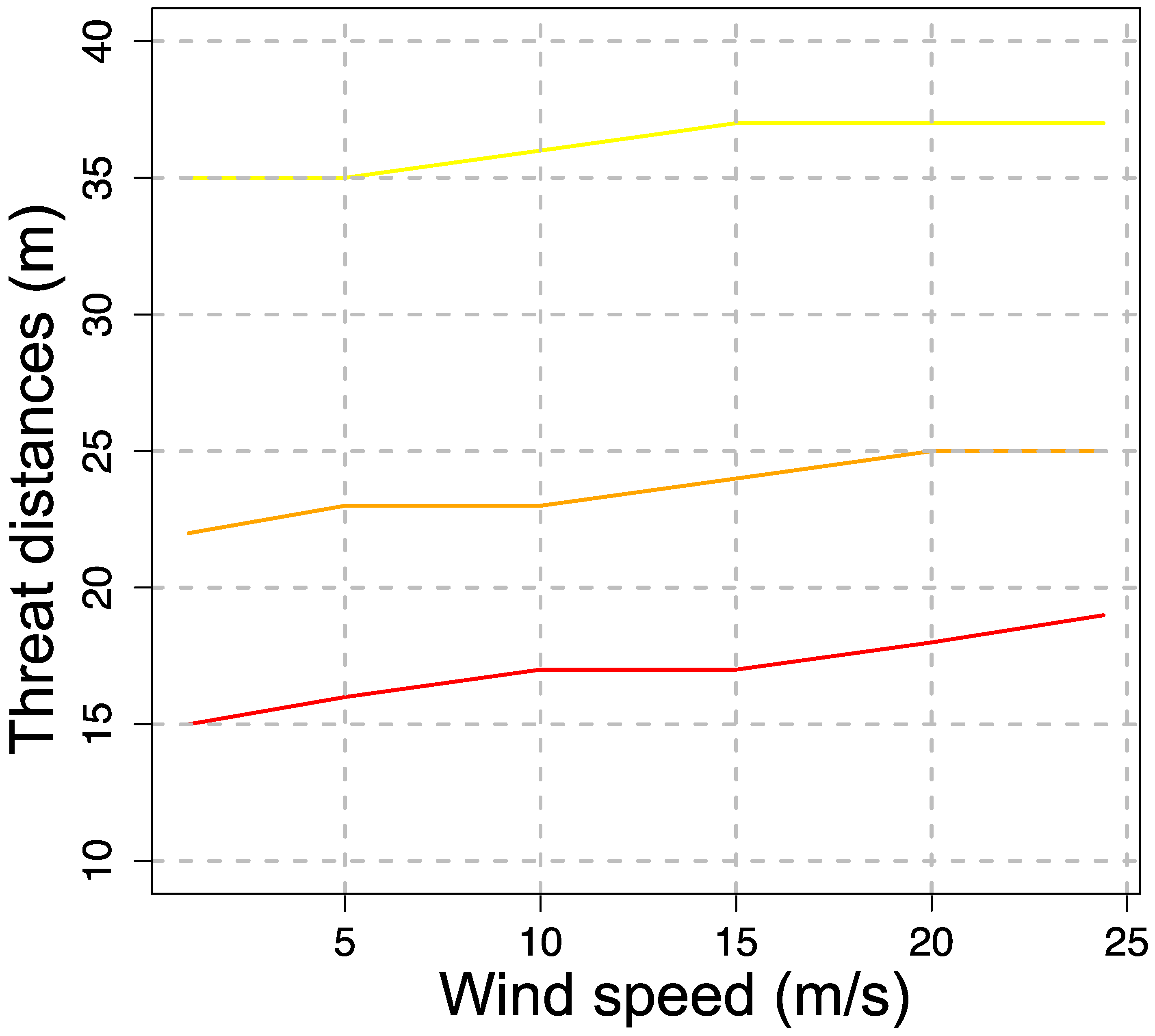
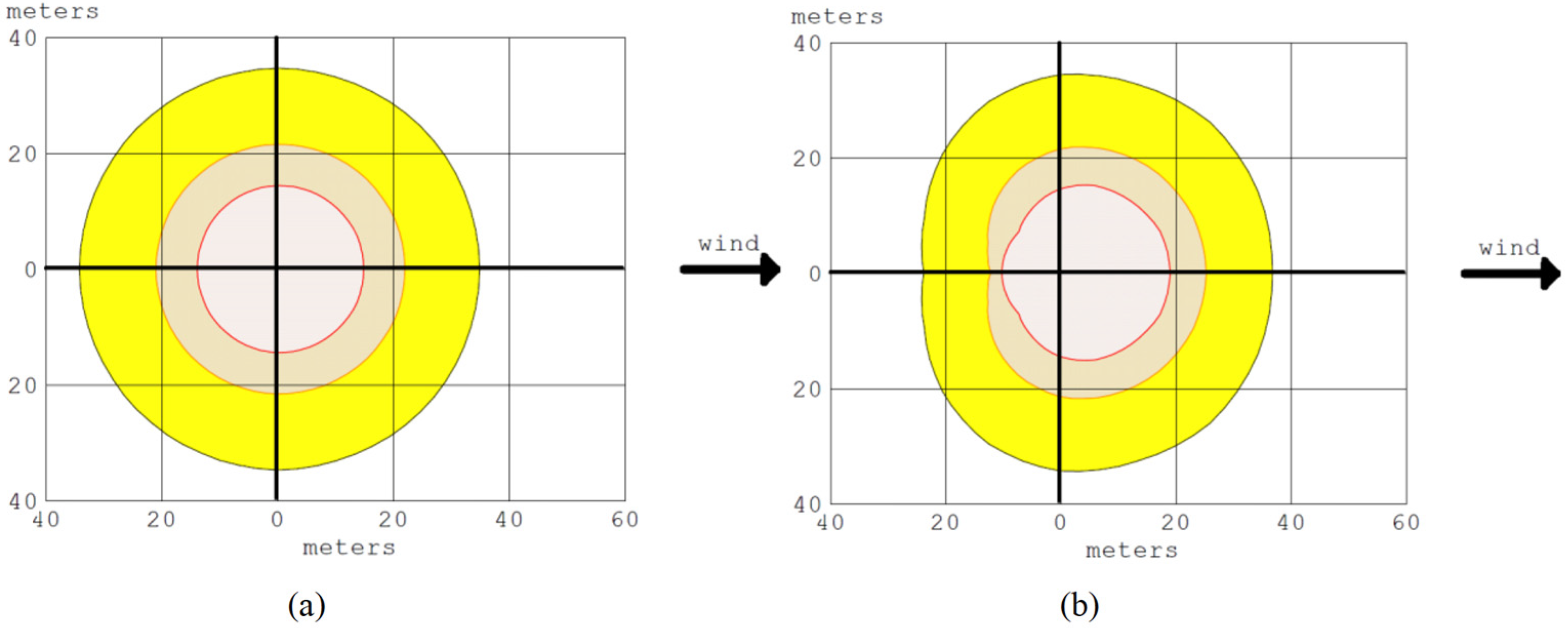

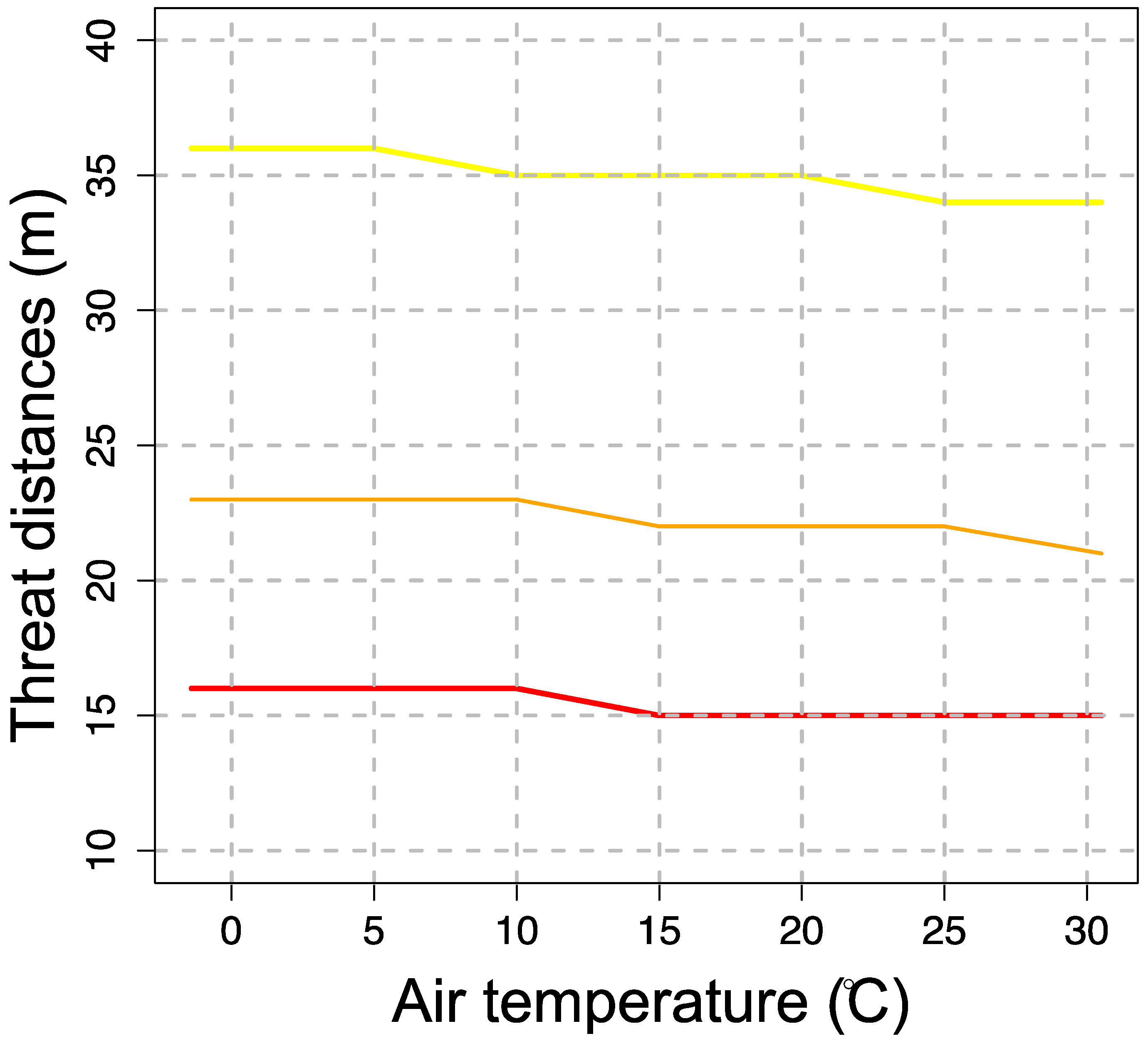

Disclaimer/Publisher’s Note: The statements, opinions and data contained in all publications are solely those of the individual author(s) and contributor(s) and not of MDPI and/or the editor(s). MDPI and/or the editor(s) disclaim responsibility for any injury to people or property resulting from any ideas, methods, instructions or products referred to in the content. |
© 2024 by the authors. Licensee MDPI, Basel, Switzerland. This article is an open access article distributed under the terms and conditions of the Creative Commons Attribution (CC BY) license (https://creativecommons.org/licenses/by/4.0/).
Share and Cite
Besiktas, R.; Baltaci, H.; Akkoyunlu, B.O. Simulation of the Jet Fire Using Atmospheric Dispersion Modeling (ALOHA): A Case Study of Natural Gas Pipeline in Istanbul, Türkiye. Atmosphere 2024, 15, 456. https://doi.org/10.3390/atmos15040456
Besiktas R, Baltaci H, Akkoyunlu BO. Simulation of the Jet Fire Using Atmospheric Dispersion Modeling (ALOHA): A Case Study of Natural Gas Pipeline in Istanbul, Türkiye. Atmosphere. 2024; 15(4):456. https://doi.org/10.3390/atmos15040456
Chicago/Turabian StyleBesiktas, Remzi, Hakki Baltaci, and Bulent Oktay Akkoyunlu. 2024. "Simulation of the Jet Fire Using Atmospheric Dispersion Modeling (ALOHA): A Case Study of Natural Gas Pipeline in Istanbul, Türkiye" Atmosphere 15, no. 4: 456. https://doi.org/10.3390/atmos15040456
APA StyleBesiktas, R., Baltaci, H., & Akkoyunlu, B. O. (2024). Simulation of the Jet Fire Using Atmospheric Dispersion Modeling (ALOHA): A Case Study of Natural Gas Pipeline in Istanbul, Türkiye. Atmosphere, 15(4), 456. https://doi.org/10.3390/atmos15040456





